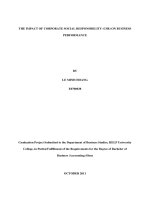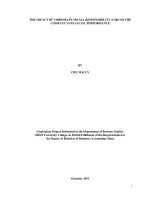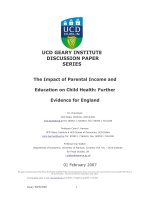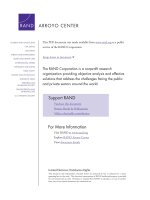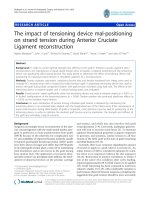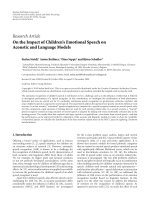The impact of summer in-service teacher training on teacher change = Nghiên cứu về thay đổi của giáo viên dưới tác động của chương trình bồi dưỡng chuyên môn nghiệp vụ hè
Bạn đang xem bản rút gọn của tài liệu. Xem và tải ngay bản đầy đủ của tài liệu tại đây (781.86 KB, 47 trang )
VIETNAM NATIONAL UNIVERSITY, HANOI
UNIVERSITY OF LANGUAGES AND INTERNATIONAL STUDIES
FACULTY OF POST-GRADUATE STUDIES
TÔ
́
NG THI
̣
THU
A CASE STUDY:
THE IMPACT OF SUMMER IN-SERVICE
TEACHER TRAINING ON TEACHER CHANGE
NGHIÊN CỨU VỀ THAY ĐỔI CỦA GIÁO VIÊN
DƯỚI TÁC ĐỘNG CỦA CHƯƠNG TRÌNH BỒI DƯỠNG
CHUYÊN MÔN NGHIỆP VỤ HÈ
M.A MINOR THESIS
Field: English Language Teaching Methodology
Code: 60-14-10
HANOI – 2011
VIETNAM NATIONAL UNIVERSITY, HANOI
UNIVERSITY OF LANGUAGES AND INTERNATIONAL STUDIES
FACULTY OF POST-GRADUATE STUDIES
TÔ
́
NG THI
̣
THU
A CASE STUDY:
THE IMPACT OF SUMMER IN-SERVICE
TEACHER TRAINING ON TEACHER CHANGE
NGHIÊN CỨU VỀ THAY ĐỔI CỦA GIÁO VIÊN
DƯỚI TÁC ĐỘNG CỦA CHƯƠNG TRÌNH BỒI DƯỠNG
CHUYÊN MÔN NGHIỆP VỤ HÈ
M.A MINOR THESIS
Field: English Language Teaching Methodology
Code: 60-14-10
Supervisor:Lê Văn Canh, Ph.D
HANOI – 2011
LIST OF ABBREVIATIONS
MOET: Ministry of Education and Training
YLSS: Yen Lac Secondary School
CPD: Continuing Professional Development
INSET: In-service Teacher Training
EFL: English as a Foreign Language
TEFL: Teaching English as a Foreign Language
LISTS OF TABLES AND FIGURES
Chapter 1
Table 1.1. Differences between training and development
Chapter 2
Table 2.1: Summary of participant selection as it occurred in my study.
Table 2.2: Summary of interview participant details.
TABLE OF CONTENTS
Acknowledgements……………………………………………………………………
Abstract………………………………………………………………………………….
Lists of Abbreviations……………………………………………………………………
Lists of Tables and figures……………………………………………………………….
Table of contents…………………………………………………………………………
PART A: INTRODUCTION…………………………………………………………
1. Introduction ……………………………………………………………………
2. Rationale …………………………………………………………………………
3. Aims and objectives of the study………………………………………………
4. Research questions……………………………………………………………….
5. Scope of the study………………………………………………………………
6. Methods of the study…………………………………………………………….
7. Significance of the study ………………………………………………………
8. Design of the study………………………………………………………………
9. Summary ………………………………………………………………………
PART B: DEVELOPMENT
CHAPTER 1: THE LITERATURE REVIEW……………………………………….
1. Introduction………………………………………………………………………
2. Teacher training and teacher development
3. Continuing professional development (CPD) and In-Service Teacher Training
(INSET)…………………………………………………………………………
4. INSET activities and their impact on teacher development…………………….
5. Factors affecting the actualization of INSET activities………………………….
5.1. Societal factors………………………………………………………………
5.2. School/local education authorities‟ expectations……………………………
5.3. Contextual and cultural factors……………………………………………
6. Studies on the impact of short training workshops on teacher change ………….
7. Summary ………………………………………………………………………
i
ii
iv
v
vi
1
1
1
2
3
3
3
4
4
4
5
5
5
7
8
9
9
10
10
11
12
CHAPTER 2: THE STUDY……………………………………………………………
1. Introduction ……………………………………………………………………
2. The case and participants………………………………………………………
3. Research methods………………………………………………………………
3.1 Development of the interview schedule…………………………………….
3.2 Classroom observation ………………………………………………………
3.3 Post-observation interview ………………………………………………….
4. Data analysis and findings………………………………………………………
4.1 Data analysis…………………………………………………………………
4.2 Findings………………………………………………………………………
4.2.1 Teachers‟ opinions of the impact of the summer in-service
workshops on their teaching ……………………………………………………
4.2.2 Teachers‟ opinions of the limitations of the summer in-service
workshops ………………………………………………………………………
4.2.3 The impact of the summer in-service workshops on teachers‟
classroom teaching ……………………………………………………………
4.2.4 Discussions of the findings………………………………………….
5. Summary …………………………………………………………………………
PART C: CONCLUSIONS…………………………………………………………
1. Conclusions of the study……………………………………………………….
2. Limitations of the study……………………………………………………………
3. Suggestions to enhance INSET activities …………………………………………
4. Suggestions for further research…………………………………………………
REFERENCES………………………………………………………………………….
APPENDICES ………………………………………………………………………….
13
13
13
14
15
17
17
17
17
18
18
21
24
27
29
30
30
30
31
31
32
PART A
INTRODUCTION
1. Introduction
In this part I present the rationale for carrying out this study. This is followed by a
brief presentation of the aims and objectives, the research questions, the methods, the
scope and the significance of the study. Finally, the design of the thesis is presented.
2. Rationale
Teacher development is a never ending cycle of teacher learning that begins with
initial teacher training and continues for as long as a teacher remains in the
profession. The fact that teaching is a public profession places teachers in the
spotlight of societal expectations of continually finding ways to improve student learning.
The way to make this possible is by enabling teachers to “continue to evolve in the use,
adaptation and application of their art and craft” (Lange, 1994, p. 250). Hence, the terms
teacher development, in-service teacher training (INSET), and continuing professional
development (CPD), are often used in a broad sense to refer to all forms of formal and less
formal learning undertaken by teachers during the course of their career (Craft, 2000).
Teachers undertake learning during their careers not only because they lack knowledge but
also because there is an obvious need for teaching professionals to cater to the needs of a
continually and rapidly changing world.
The government has been showing its commitment to educational reform for the
last few years. In 2008, the Vietnamese Prime Minister issued Decree N° 1400/QD-TTg on
approving the National Plan for “Teaching and Learning Foreign Languages in the
National Formal Education System in the period of 2008 - 2020”, according to which one
of the major tasks is to enhance teacher professionalism and develop a professional force
which is able to implement the new curriculum. In order to achieve the goal of the new
curriculum, teachers really need great support in different aspects to help them grow
professionally. Hence, The Ministry of Education and Training (MOET) focused on
developing teachers by encouraging INSET activities among teachers as a mandatory
requirement. As a result, INSET activities, which usually appeared in the form of short
workshops, have been organized annually during the summer time by the Department of
Education and Training of Vinh Phuc to EFL teachers in order to encourage them in their
classroom teaching improvement. The purpose of my thesis is then to investigate the
impact of summer in-service workshops on teacher change in their classrooms in Yen Lac
Secondary school (YLSS), in Vinh Phuc, with the focus on their opinions of the
effectiveness, the limitations and the practice of these short courses in their classrooms.
My interest is to explore the change of teachers of English as a Foreign Language
(EFL) which plays a significant role in the lives of teachers. I am also familiar with the
context and some of the factors that affect the INSET activities of these teachers. Such
factors include opportunities to engage in development events. I have worked for the
Education and Training Department of Vinh Phuc for seven years now and my role
involves organizing summer in-service workshops for English language teachers in Vinh
Phuc. Through the feedback gained on these workshops organized and through
personal interactions with teachers from local schools who were either participants or
presenters, I obtained useful feedback about these summer in-service workshops. To the
best of my knowledge there has been little research carried out or literature
produced on the summer in-service workshops of EFL teachers in secondary schools in
Vinh Phuc. As a result, there is minimal or no insight into the teaching practice in local
schools. Hence, the aim of my study is to investigate the impact of summer in-service
training workshops on class teaching of the teachers at Yen Lac Secondary School, in Vinh
Phuc Province. Through an exploration of their experiences, I expect to develop a
better understanding of how EFL teachers can be supported in their INSET efforts both
within their schools and outside.
3. Aims and objectives of the study
The study aims to find out the impact of summer in-service workshops on teachers‟
teaching practices as reported by the teachers participating in these workshops
In order to achieve the above aim, the study seeks to achieve the following
objectives:
1. To understand teachers‟ opinions of the impact of summer in-service workshops
on their teaching.
2. To explore how summer in-service workshops affect their actual classroom
teaching.
4. Research questions
The following research questions guide my investigation:
1. What are teachers‟ opinions of the impact of summer in-service workshops on
their teaching?
2. What are teachers‟ opinions of the limitations of the summer in-service
workshops?
3. What impact do the summer in-service workshops have on teachers‟ classroom
teaching?
5. Scope of the study
It would be too ambitious for this small-scale thesis to specify all aspects of in-
service teacher training activities. Therefore, the researcher would like to focus only on the
impact of summer in-service workshops on teachers‟ classroom teaching. The subjects of
the thesis are three EFL teachers of YLSS.
6. Methods of the study
With reference to the aims of the study, a semi-structured interview in the first
stage of the study was conducted. This was followed by classroom observations, which
were for the purpose to probe deeply into the impact of short in-service workshops on
teacher‟s classroom teaching. In the last place of the study, a post-observation interview
was made to find out the major barriers of the implementation of the training content.
These procedures were aimed at collecting rich data about views on the impact of the
summer in-service workshops on teachers‟ classroom practice through the teachers‟
opinions and their classroom teaching.
7. Significance of the study
Findings from this case study can provide teacher educators and administrators
useful information about the needed improvement on teacher in-service workshops. Such
improvement is to support teacher change better so that the quality of English language
teaching at the high school can be raised.
8. Design of the study
The research study is organized into three parts:
Part A - Introduction - provides basic information including the rationale, aims,
research questions, scope, methods, significance and the design of the study.
Part B – Development - is composed of two chapters. Chapter 1 reviews the
related literature on teacher training and development, continuing professional
development and in-service teacher training activities.
Chapter 2 presents the information about the case school, detailed methodology,
data collection and analyses followed by the findings.
In part C – Conclusion - I present a summary of major findings of the research and
suggestions to enhance INSET activities of EFL teachers in the context, as well as
suggestions for further research into the topic of in-service workshops as a teacher
development activity.
9. Summary
In this part I present the reasons why I conducted this study as well as how the
study was conducted. In the next par – Part B – I will present the literature review of the
study.
PART B: DEVELOPMENT
CHAPTER 1
THE LITERATURE REVIEW
1. Introduction
In this chapter, it seeks to understand the notion of teacher training and teacher
development; continuing professional development (CPD) and in-service teacher training
(INSET) in the literature. The chapter also discusses the INSET activities and their impact
on teacher development. Towards the end of the chapter, it discusses the factors affecting
the actualization of INSET activities of EFL teachers. The chapter concludes with insight
into some recent researches on the impact of short training workshops on teacher change.
2. Teacher Training and Teacher Development
In the literature, terms such as teacher training, teacher development, teacher
education, and teacher preparation have been and often continue to be used
interchangeably. According to Freeman (1989), the term teacher education is preserved as
the superordinate or an umbrella term, whereas teacher training and teacher development
are used to describe the strategies by which teachers are educated. Thus, Freeman (1989)
defines training as
…a strategy for direct intervention by the collaborator, to work on specific aspects
of the teacher‟s teaching. The intervention is focused on specific outcomes that can
be achieved through a clear sequence of steps, commonly within a specified period
of time. The aspects of teaching that are seen as “trainable” are discrete chunks,
usually based on knowledge or skills, which can be isolated, practiced, and
ultimately mastered.” (p. 39)
Development, in contrast, is a strategy of influence and indirect intervention that
works on complex, integrated aspects of teaching. The purpose of development is “for the
teacher to generate change through increasing or shifting awareness” (Freeman, 1989, p.
40). As such,
development is a far less predictable or directed strategy than training. It is highly
dependent on the individual teacher, the collaborator, and their interaction (p. 41).
According to these definitions, teacher training and teacher development are two
basic educating strategies that share the same purpose: achieving change in what the
teacher does and why. They differ in the means they adopt to achieve that purpose.
Freeman (1989) highlights the differences between these strategies in Table 2.1 below.
Table 1.1. Differences between training and development (Freeman, 1989, p. 42)
Teacher training
Process of direct
intervention
Teacher development
Process of influence
Characteristics of
aspects of teaching
focused on
Generally accessible; can be
mastered through specific
courses of action
Idiosyncratic and individual;
mature through constant
attention, critique, and
involvement of the teacher in
his or her teaching
Constituent base
Focus
Knowledge and skills
Initiated by collaborator,
work carried out by teacher
Attitude and awareness
Raised by collaborator, but
work initiated by teacher
Criteria for assessing
change
External; accessible to the
collaborator
Internal; personal to teacher
Closure
Can be within a fixed time
period, once criteria are
satisfied
Is open-ended; work continues
until teacher decides to stop
For the purpose of this study, which looks at the impact of short summer
workshops on teachers‟ classroom teaching, the term „training‟ is used. This is because the
aims and objectives of these workshops are to provide teachers with new discrete teaching
skills and classroom techniques.
3. Continuing Professional Development and In-service Teacher Training
The term continuing professional development refers to all the activities in
which teachers engage during the course of a career which are designed to enhance their
work‟ (Day & Sachs, 2004, p.3). CPD is often described in the literature using terms such
as staff development, career development, human resource development, continuing
education and lifelong learning. The term is also widely used interchangeably with the
term in-service teacher training.
According to Canh, continuing professional development is a way of learning from
what you do so that you can do it better (Canh, 2004, p.127). For a language teacher, it
seems to be always right. For the good teacher, every facet of his knowledge, skills,
personality, and interests are of potential professional value (Euan, 1978, p.11). Hence
every experience he undergoes in his career may be described as in-service teacher
training, also known as teacher development or continuing professional development
(CPD). Therefore, in-service teacher training may, in the most general sense, be taken to
include everything that happens to a teacher from the first day of his teaching career to the
day he retires which contributes, directly or indirectly, to the way in which he executes his
professional duties. Thus, in the United Kingdom, the Department of Education and
Science (1970) has defined in-service teacher training as: “Any activity which a teacher
undertakes, after he has begun to teach, which is concerned with his professional work.”
In-service teacher training(INSET) is one form of teacher education which refers to
the policies and procedures designed to equip teachers with the knowledge, attitudes,
behaviours and skills they require to perform their tasks effectively in the school and
classroom and which includes initial teacher training(a pre-service course before entering
the classroom as a fully responsible teacher) and induction (the process of providing
training and support during the first few years of teaching or the first year in a particular
school) as well. Teachers who are essential to the high-quality education, are subjective
and the most active factor in educational activities, to whom CPD is fundamentally
important.
Teachers, in general, in Vinh Phuc province are relatively of lower level in
knowledge and teaching skills, which has well affected and is still affecting the
achievement of the goal of the provincial education, especially the one of elementary and
secondary schooling. In-service teacher training is regarded as best way to improve the
teachers‟ abilities and skills. But the existing problems, such as teachers‟ personal need,
inefficient training, and financial problems, prevent in-service teacher training from
functioning in improving the teachers‟ quality in the locality.
4. INSET activities and their impact on teacher development
The terms CPD and in-service teacher training (INSET) are sometimes
interchangeably used. INSET can be defined as all in-service teacher training activities that
professionally qualified teachers engage in to improve their professional knowledge,
skills and attitudes and to educate learners more effectively (Roberts, 1998). It
assumes that teachers engaging in INSET have acquired basic knowledge of teaching
and learned basic teaching skills in their initial teacher education (Eraut, 1994), and
that INSET activities can make teachers aware of the various options available that can
help improve their current practice (Richards & Nunan, 1990). INSET tends to be
interpreted as a range of time-bound (Day, 1999), structured, formal and top-down in-
service learning activities designed to bridge the gap between teachers‟ current level of
skills and knowledge and the level required by their role in the system (Roberts, 1998).
Often perceived as the quickest and most economic way of developing teachers on the job
(Gaunt, 1995), it thus incorporates elements of both training as well as development.
INSET activities may be accredited or non-accredited and can be distinguished from less
formal in-service training and development work that teachers also engage in (Day, 1999).
INSET, however, is perceived to include both formal structured opportunities, such
as INSET activities that may be required by external agencies (such as schools where
teachers are employed) and are facilitated by others (such as INSET providers)
(Evans, 2002), and less formal opportunities which may be initiated by individuals or
groups of teachers employed within the same schools or groups of schools. Such less
formal activities can be ongoing and self-initiated and effected. Irrespective of whether the
process is training dominated or not, INSET is likely to improve teachers‟ knowledge,
skills and practice and as a result enhance their professional status by moving teachers
towards expertise (Kelly, 2006). The idea of short or long term INSET for serving
teachers implies the presence of training inside the development process, which is
intended to prepare them for present responsibilities (O‟Neill, 1994), or to develop
externally specified skills, behaviours and strategies (James, 2001) that may equip teachers
to immediately implement the learnt strategies in the classroom (Guskey, 2000).
Nevertheless, teacher development is a continuum of learning in the context of the
teacher‟s whole career, with teachers within a school located at various places along the
continuum. Learning during the early years is generally aimed at developing
understanding of practice, followed by later periods of reflection on work and
discussion due to which teachers may continue to gain new insights and improve their
skills. This is where a programme of INSET is so important and may take the various
approaches or forms described in this section according to the teacher‟s individual or
contextual needs.
5. Factors affecting the actualization of INSET activities
In any context, the INSET choices made or available depend on societal
expectations of teachers, school/local education authorities‟ requirements, the contextual
culture in which teachers work and subsequently their own values and beliefs as well.
5.1 Societal factors
Teaching as a public job is powerfully affected by societal norms and
expectations (Roberts, 1998), which makes it pertinent that teachers continually try to
find ways to improve student learning; this constitutes development for teachers and
will in the process convince society that they are a proper profession. Hence, by
learning new strategies to cope with constant and complex change (Hopkins, 2002),
teachers are expected to continually meet high standards of teaching and raise the
levels of learner achievement in their schools. It can be understood then that while
INSET can be independent of the organisation, it often functions more successfully
with its support and recognition (Mann, 2005).
5.2 School/local education authorities’ expectations
Teachers today, as Craft (2000) highlights, are under immense pressure to
undertake specific development courses for improved quality teaching. INSET thus
bears significance not only for the teachers involved but also for the learners, the schools
and subsequently for the society at large. The greatest impact on choice of INSET is
perhaps the school where teachers are employed. They must necessarily adhere to the
school‟s requirements and policies in terms of teacher development. This is most evident in
schools where teachers are expected to engage in specific types of INSET in order to fulfill
school goals which ultimately result in realization of educational goals that are part
of the government‟s policies towards national development. This appears essential in
view of the fact that recently Vietnam has been engaged in a whole-scale review of the
educational system in the country. To meet the challenges of rapid change, education
authorities in Vietnam has gradually recognized of the importance of INSET through
teacher education, teacher support and development structures in universities, schools and
vocational training institutions.
5.3 Contextual and cultural factors
As teaching is a situated and social activity, the impact of INSET activities on
teachers‟ actual practices is understandably affected by socio-cultural factors. These
factors include collegial support and cooperation, teachers‟ motivation and knowledge, the
curriculum requirements, the students‟ expectations, the school leadership, and the wider
social context. Therefore, an investigation of the impact of the summer in-service
workshops on teachers‟ classroom teaching can not be separated from the social context in
which teaching occurs.
To summarize, the way INSET is actualised or pursued and the choices made
available or opted for are affected by expectations and requirements of public, schools and
the local education authorities‟ requirements. It is also affected by the aspirations of
individual teachers, their contextual requirements, the opportunities made available in that
context, and the economic factors that enable such opportunities. Part of the complex
picture of actualising INSET are also the values and beliefs of teachers within those
socio-cultural and community cultures which together interact to influence what
decisions are taken and what opportunities are made available.
6. Studies on the impact of short training workshops on teacher change
One of the greatest concerns in teacher development is how to bridge the gap
between theory and practice. In general, there is a shared opinion that both theory and
practice are of crucial importance for language teacher education (Stern & Strevens, 1983).
Training, as observed by Duff (1988), should be practical and directly applicable to the
teaching context. At the same time, there is a broad agreement that practice needs to be
based on theory (Duff, 1988).
In spite of the fact that language teacher education clearly needs theory and
practice, most existing in-service teacher training programs are criticised for having their
major focus on either one or the other (Jarvis & Smith, 1980; Stern & Strevens, 1983).
This means that the effectiveness of training depends to a large extent on how far that
training is transferred to the real classroom situation. Although no teacher training program
can guarantee such a transfer, Altman recalls an old aphorism: “Teachers teach the way
they are taught, not as they were told to teach” (Altman, 1983, p. 233). In other words, this
would imply that language teachers should be trained the way they are expected to teach.
For „learner-centred‟ teaching to be carried out by classroom teachers they should have
been exposed to a teacher-centred INSET. Most scholars agree that effective INSET
courses should be teacher-centred, interactive and integrative (i.e. it should allow for
different kinds of teaching modes and procedures (Candlin, 1983).
Recently, there has been interest in the effect of INSET courses on teachers‟ latter
practice. There has been a clash between the new and the traditional, illustrated by
comparing INSET course content with later classroom practice. In Vietnam, Lewis and
McCook (2002) examined the views of 14 Vietnamese high school teachers of English, as
expressed in their journal entries during on-going INSET workshops conducted by the
researchers themselves. The results showed that teachers were applying what they had
been introduced to during the course. However, these were reported by the teachers
themselves and no observational data were provided to justify what the stated.
For many years in Vietnam and in many other developing countries, in-service
training workshops or short-term courses that would offer teachers new information on a
particular aspect of their work. Particularly in the context of Vietnamese secondary
schools, this has been the only type of training teachers would receive.
7. Summary
This chapter reviews the literature on teacher development with an emphasis on
summer in-service workshops. Factors affecting the effectiveness of those workshops have
also been reviewed. The next chapter presents the study.
CHAPTER 2
THE STUDY
1. Introduction
This chapter provides information about the study. Firstly, information about the
case and the participants, then the research methods and research procedures is provided.
This is followed by the presentation of the findings and the discussion of those findings.
2. The case and participants
The study involved three EFL teachers working in Yen Lac Secondary School
(YLSS), which is located in a countryside district of Vinh Phuc. It is a relatively large
school with about 1600 students in the three final grades (Grades 10 to 12); most of the
students come from farmer families. The average class size in this school is around 40 and
the classrooms are cramped with very basic school facilities. There are over seventy
teachers working at school, most of whom are full time teachers. There are eight EFL
teachers among them, with teaching experience ranging from three to sixteen years. Six of
them are female and they graduated from different colleges of foreign languages, then their
English proficiency and teaching methods are various in terms of the quality. Thus short
in-service workshops organized by educational authorities every summer help them to
meet the requirement of the classroom teaching. All of EFL teachers at the case school
have participated in these in-service teacher training workshops run by university lecturers
or key teachers.
Participants in my study consist of three English-language teachers at YLSS. They
are thus full time teachers, a male and two female teachers with a minimum of three
years‟ experience of teaching English. Two of them graduated from University of
Languages and International Studies - VNU Hanoi, while the other teacher graduated from
the local Teacher Training College, Phu Tho. One of the reasons for including such a
selection of teachers is to be able to generate a broad range of opinions, insights and
experiences of EFL teachers about summer in-service workshops. The choice will thus
ensure that participants in my study are teachers with sufficient experience in both
TEFL and in INSET.
Summary of participant selection as it occurred in my study
Research
tools
Context
Selection criteria
Participants
Semi-
structured
interview
Three
EFL
teachers
of YLSS
(a) EFL teachers with more than three years
of teaching experience
(b) Teachers who could participate in the
interview on the same day as others
One male and
two female
EFL teachers
Classroom
observation
Three
EFL
teachers
of YLSS
(a) Teachers who participate in the semi-
structure interview
(b) Teachers who are comfortable with
their lessons being observed
One male and
two female
EFL teachers
Post-
observation
interview
Three
EFL
teachers
of YLSS
(a) teachers whose classes are observed
(b) Teachers who can participate in the
post-observation interview on the same day
of the class observation
One male and
two female
EFL teachers
Table 2.1: Summary of participant selection as it occurred in my study.
Interview participant details
Interviewee code
Gender
School
Years of teaching
Teacher A
Female
YLSS
3
Teacher B
Female
YLSS
14
Teacher C
Male
YLSS
14
Table 2.2: Summary of interview participant details.
3. Research methods
As I have argued earlier, teaching is social, and the study of the impact of the
summer in-service workshops on teachers‟ teaching should be conducted in one particular
context. This is the rationale for my choice of a qualitative case study design for this study.
In order to achieve the aims and objectives of the study, three instruments were
used to collect the data: semi-structured interviews, classroom observations, and post-
observation interviews. By using these different instruments, I was able to achieve the
triangulation of the data, thereby increasing the reliability and credibility of the findings
(Denzin, 1978).
The semi-structured interview was used to aim at gaining a general picture of the
teachers‟ opinions and their justifications on issues concerning in-service teacher training
workshops. On the whole, the data from the semi-structured interview presented the
opinions and the limitations of the impact of summer in-service workshops on their
teaching as perceived by EFL teachers at Yen Lac Secondary School; the interview
provided qualitative data that enhance the depth and consistency of the study. Then the
classroom observation and post-observation interview provided data about the actual
teaching of the subjects and help the researcher examine whether their teaching reflects
what they responded to the semi-structured interviews.
3.1 Development of the interview schedule
The interview schedule was informed by my original research questions (See
appendix A for interview schedule) based on my interest in the subject and my
awareness of the phenomenon of short summer in-service workshops in the researched
context. The interview schedule was also informed by the literature. In order to understand
and interpret the meaning of the phenomenon of summer in-service workshops to
participants, I explored in depth seventeen open ended questions in face to face
interviews. Questions in the semi- structured interview schedule thus broadly focused on
the following categories of enquiry:
- Participants‟ opinions of the impact of summer in-service workshops
- Possible limitations of summer in-service workshops that participants have
recently involved in
- The impact of summer training workshop on teachers‟ classroom practice
A week ahead of their scheduled interviews, I e-mailed interviewees asking
them to reflect on the above mentioned aspects so that they would be mentally prepared to
focus on the subject of enquiry. It also put them at ease, saved time that would otherwise
be spent in explaining the questions asked and proved useful in retaining focus during the
interview. The interview schedule was designed to last about an hour bearing in mind
that anything less than half an hour was unlikely to be valuable and more than an hour
would be making unreasonable demands and could result in fewer persons willing to
participate (Robson, 2002).
Time and venue of the interview
A quiet and large classroom was chosen and considered to be a convenient place
for conducting the interview, where privacy and confidentiality were assured. The duration
of the interviews lasted for about 60 minutes. It seemed suitable for the interviewer to raise
the major issues and the interviewee could feel free to elaborate and explain wherever they
considered necessary.
Procedures of the interview
In order to enhance the internal validity of the study, the process of the interview
was followed by the sequence of interview questions. Firstly, the purpose of the interview
was clearly stated and some warm up questions were asked to let the interviewer and
interviewee to be ready. It was followed by some thematic questions as the major part of
the interview. Lastly, certain cool-off questions were asked to lower the tension established
in the major part of the interview and the whole process was ended by expressing the
gratitude to the interviewee. In certain case that the interviewer was not clear about the
interviewees‟ interpretation during the process of data analysis, clarification was done after
a reasonable period of time.
3.2 Classroom observation
McMillan and Schumacher (1997, p.268) contend that observation is very different
from interviews and questionnaires. They argue that the observation method relies on a
researcher seeing, hearing and recording things which are happening in the classroom
situation. It notes that observation involves gathering live data from live situations and this
is what I have done.
In this study, I observed a total number of six lessons from three selected teachers
(two lessons per teacher) in the case school. I used classroom observation because I wanted
to see what teachers actually performed in their English classes. The other reason why I
conducted classroom observation was to provide me with some knowledge of what and
how teachers put the contents of the short summer in-service training workshops into
practice. While observing the teachers, I took detailed notes of activities they used in the
classroom (See Appendix C for the observational notes)
3.3. Post-Observation Interviews
Each teacher was interviewed after the last classroom observation in about 20
minutes (See the Post-observation Interview Guideline in Appendix B). The interview
focused on critical issues arising from the observed lessons, which related to the
application of what they learned from short summer training courses. All the interviews
were conducted in Vietnamese so that the participants could fully express their views
without being constrained by the use of a second language. The interviews were then
analysed by the researcher to identify main themes.
4. Data analysis and findings
4.1 Data analysis
This study was based on different data sources which consisted of semi-structured
interview, classroom observation and post-observation interview. The process of data
analysis may be quite different according to the nature of these data. For the data collected
in the semi-structured interview, which is relatively qualitative in nature, was then coded
so that readers could easily observe the general picture of EFL teachers‟ opinions of the
impact of summer in-service workshops on their teaching in the case school. Analysis and
interpretation were totally based on what the data told so that it revealed the native
perspective of the informants. All data collected in the study were examined and coded so
that I could identify themes and patterns that helped to answer my research questions.
Based on the findings of this study, I discussed and tried to suggest some measures to be
adopted by the Department of Education and Training of Vinh Phuc, schools and
individual teachers in the planning of the future teacher in-service workshops.
4.2 Findings:
As mentioned above, methods of data collection of this research include the semi-
structured interview, the classroom observation and post-observation interview. For the
qualitative data collected from the semi-structured interview, explanations and discussions
generated from the views and opinions of the informants will be illustrated and supported
with appropriate quotations. With deeper understandings about the teachers‟ application of
summer in-service training workshops in their classrooms, it helps to draw conclusions and
make further suggestions for the educators in planning and policy-making processes of
INSET activities.
4.2.1 Teachers’ opinions of the impact of the summer in-service workshops on
their teaching
The aims of organizing summer in-service workshops to encouraged teachers of
English to overcome what has traditionally been the method of teaching and learning
English. In this tradition teachers were the bearers and deliverers of knowledge and
students were the passive learners. It was a teacher-dominated approach to teaching and
learning. Given this, the new teaching methods demanded a more student-centred teaching
and learning, which in turn meant that teachers required in-service training workshops on
what were deemed effective teaching strategies and classroom techniques to be able to
deliver the class teaching in ways that were more meaningful. Accordingly, the research
question was designed to obtain the EFL teachers‟ opinions of the effectiveness of summer
in-service workshops in helping them to implement the new teaching skills into classroom
practice in YLSS.
Effectiveness of New Teaching Strategies and Classroom Techniques
Teachers in the study identified the usefulness of the various teaching
techniques and strategies learned in the in-service workshops to help them improve
their classroom practice. They noted that the trainers provided them with numerous ways
in which teachers had opportunities to practice different teaching models that they could
use in the classroom.
Teacher A says:
…I found the training very useful as I improved my English to some extent,
I came up with different teaching techniques such as group/pair activities,
role play, games and visual aids which helped my students to learn.
Teacher C shared the opinion and added that:
Yes…it has helped me reinforce my experience from the previous years
in the sense that for example the focus of the more on interactive teaching
The teachers also commented on the training content that their English teaching has
improved as a result of attending the in-service training workshops. Some of the typical
comments of the three interviewed teachers are outlined below:
We have become equipped with more interactive ways on how to teach English
We have to make lessons more interesting so students become more active and
motivated to participate in the class activities.
Teachers in the study also noted that the training workshops offered numerous
strategies and techniques to help students who had very limited use and understanding of
English
I select those appropriate to our learning context, for example,
to encourage students to speak, I use the throw and catch method
using a ball or piece of paper…It is not so expensive and difficult
to practice in my classroom (Teacher A, the youngest teacher says)
Overall, teachers thought that summer in-service workshops encouraged them to
look at interactive approaches for engaging student learning.
Effectiveness of Trainer Teaching Strategies and Classroom Techniques
Teachers in the study felt that the trainers and their teaching methods in the
training workshops were the also contributing factors in ensuring the success of the
programme. They found the trainers to be very helpful and forthcoming in their way of

